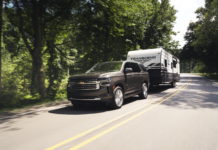
Honda is charging ahead with two in-house EVs, aiming to build both at its Ohio plant next year.
A year after teasing its first next-gen electric cars at the Consumer Electronics Show (CES) in Las Vegas, Honda is back with new prototypes for public consumption. The latest versions of the ‘0 Series’ models — a four-door sedan and an SUV — will eventually go into production at the company’s forthcoming “EV Hub” in Marysville, Ohio, in 2026.
Honda uses the British English ‘Saloon’ name for its low-slung four-door concept, and its futuristic look has carried over relatively unchanged from last year’s debut. You still get a wedge-shaped EV with no shortage of hard lines and an extremely low roofline. One significant change is at the front end, where the layered screen look of the last concept gives way to a blank panel. It’s not quite as futuristic, sure, but that does make this car look a bit more production ready. For what it’s worth, Honda did keep the old concept’s rear-end design, where you get a layered taillight effect and “Honda” lettering, although this time the text is also in red.
Despite the low profile, the Honda 0 Saloon concept does still have a large canopy around the driver, owing to a large windshield and side windows that taper inward as you move toward the rear end of the car. What you still don’t seem to get, much like the Polestar 4, is a rear window. The car’s general shape would make a conventional rearview mirror practically useless anyway, so if this shape does move forward to production, Honda will probably use a similar solution to Polestar’s and fit a camera setup instead. The side mirrors, for their part, also use cameras instead of traditional mirrors, but regulations will probably kill that in production, at least for American-market versions.

What about the SUV?
The 0 SUV still looks pretty futuristic, but brings in a few more practical elements to the wedge-shaped Saloon. It sports a more upright design at the front and the back, and you actually get a (small) rear window this time around. Generally speaking, this looks less prototype-like than the Saloon and indeed last year’s “Space-Hub”, from which this SUV looks markedly different.
The SUV gets a pixelated headlight assembly at the front, as well as a black faux grille with a backlight Honda badge to give it some contrast against the swooping hood and the lower fascia. The roofline seems to follow the Saloon as far as a low-slung and futuristic look, though you get a more pronounced kick up past the rear doors, and there’s an extra window since the doors themselves are far shorter than they are on the Saloon.
Both vehicles will utilize a similar interior setup, with a ton of ever-so-fashionable screens. You get one main display for the driver, as you typically do these days, a large central infotainment display, and another screen for the passenger. Two more displays flank the main instrument panel for the side-view cameras, though again I strongly suspect we won’t see that when the car launches stateside.
Honda’s new EVs will have AI-driven semi-autonomous capability
Love it or hate it, the Honda 0 cars also use a steering yoke in place of a traditional steering wheel. That’s because the cars will be steer-by-wire, much like the Tesla Cybertruck or the Lexus RZ. Honda also aims to make these cars capable of Level 3 autonomous driving, which would largely take the driving tasks out of human hands with an “eyes off” system, at least under certain conditions. To help achieve that goal, the automaker is leveraging its partnership with Helm.ai and its “unsupervised learning” technology with behavior models patterned on “experienced drivers” to adapt the Level 3 system to a wide varity of driving conditions. We’ll have to wait and see how that actually works when we actually test out the production-intent models, but since everything these days has to bring in artificial intelligence, it’s fitting that the 0 Series will get a similar treatment.
Honda also announced its ASIMO OS system along with the two prototypes at CES. If the name “ASIMO” sounds a bit familiar, that’s because the automaker is bringing it in as a nod to its humanoid robot, which it first showed off back in 2000, after beginning its robotics research and development in 1986.
As a software package, ASIMO OS will integrate the main electronic control unit (ECU) with the autonomous driving systems and in-vehicle entertainment systems. Naturally, it will also be capable of receiving over-the-air updates, allowing owners to purchase new functions and services after-the-fact. Hopefully that won’t effectively lock out core features behind a paywall, as has become depressingly predictable in today’s “digital first” mindset, but we’ll have to wait and see what specific features Honda intends to deliver through OTA updates to know for sure.
Speaking of actual hardware, the Honda 0 Series models will use a system-on-chip (SoC) setup from Renesas, delivering the sort of computing horsepower required to run all the cars’ operations without dramatically increasing power consumption (that’s the goal, at least). Honda 0 Series models should come in either single- or dual-motor configurations, and use the Tesla-style NACS port that automakers are comprehensively integrating into EVs this year.
We don’t know exactly how much power the production models will put out as far as their performance capabilities, what their battery capacities are and how far they’ll go on a charge, or exactly how much they’ll cost when they do go on sale. However, Honda did say the 0 SUV will go into production first, and be available in the first half of 2026. The 0 Saloon will follow later in the year.































